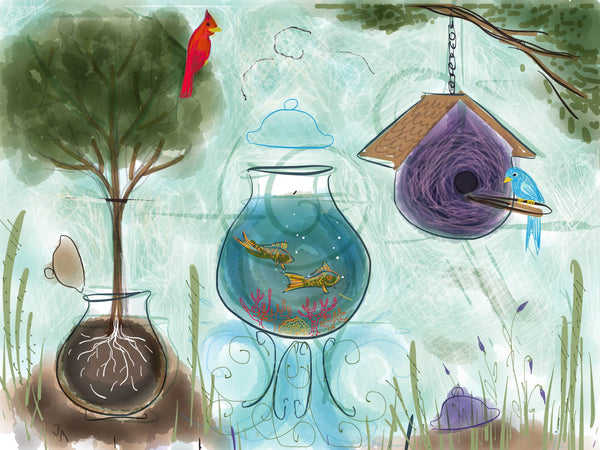by J. Malec

Illustration by J. Malec
What if we wish to create a home for new life through our death?
An active circle of life is apparent in nature. Death gives rise to new life and nothing is wasted. But in contemporary culture, this is not usually true of human death. Traditional burials entail using toxic embalming chemicals that prevent decomposition and reintegration into the earth. Scattering cremated remains reintroduces the body’s minerals back into nature. But how can our death be an intricate contribution to new life?
Birdhouse Scattering Urns
The birdhouse urn is a unique concept in scattering urns. It is the perfect memorial for an avid birder. A birdhouse can even be fashioned to attract a specific species. These elegant objects are meant to hold cremains temporarily until scattered at a memorial ceremony. Afterward, a birdhouse urn is placed close to home as a remembrance of a loved one. Birds have long been seen as a symbol of the spirit. Creating a nesting site for them allows us to continue giving back even after death.
Urns that Grow Trees
Urns that promise to turn us into a tree after death offer another refreshing option. A sound choice for gardeners or naturalists of all kinds, the Bios Urn or Spiritree Urn come with a variety of tree seeds to suit the personality of the deceased. These biodegradable urns are made of compressed material that provides nutrients for the embedded seeds. Cremains are planted with the seeds. Once sprouted, the seedling nourishes itself on the calcium-rich ashes and grows to act as a monument to the loved one.
Memorial Reef Habitat
For those who love the ocean, options such as Eternal Reefs and the Neptune Society combine the urn, ash scattering and burial at sea to create restorative environments for ocean life. Cremains are mixed with environmentally safe concrete. The mixture is cast into structural elements that are deposited in groupings to rebuild reef systems, fish habitat and food chains for larger marine animals where previous degradation occurred. Projects like these have been enormously successful in building new habitat and hold great promise as an alternative to a traditional burial. For additional information on the benefits of choosing an artificial reef as a final resting place, read our blog “Beyond the Cremation Urn – Resting in an Artificial Reef.”
Human Composting
A somewhat unique service, surprising in its scope and currently in development, is referred to as human composting. The process returns the body to the earth organically. Our recent blog “Human Recycling – the New Green” gives a brief overview. Katrina Spade, founder of the Urban Death Foundation, describes the process below:
At the top of the core [of the facility], friends and family lay the body into a mixture of woodchips and sawdust. Over the next few weeks, the body decomposes and turns into a nutrient-rich compost. The process is continuous - new bodies are laid into the system as finished compost is extracted below. After a month, a rich compost has been created, and is ready to nourish new growth.
The idea of human composting was inspired by the process of decomposition and regeneration of “nurse logs” or dead trees that provide nutrients for new life on the forest floor. Seattle’s Urban Death Project proposes composting people in nitrogen-rich plant material as a way of folding human death back into life. This type of vision points to new ways of thinking about life after death that are sure to continue to gain momentum.
Are you aware of other ways that cremation is going beyond the cremation urn and creating homes for new life? Let us know.
J. Malec is a visual artist and writer whose work often deals with themes related to loss and healing. She lives in Minneapolis, and spends much of her time practicing permaculture in the city.

